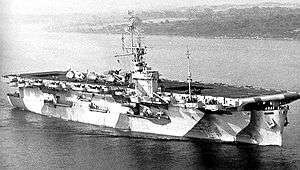USS Mission Bay (CVE-59)
 USS Mission Bay operated primarily as an ASW carrier in the Atlantic. She is shown in August 1944 off the East Coast, wearing Measure 32 Design 4A camouflage. Note the F6F Hellcats on deck and the large SK air search radar antenna on the mast. | |
| History | |
|---|---|
| Name: | USS Mission Bay |
| Builder: | Kaiser Shipyards |
| Laid down: | 28 December 1942 |
| Launched: | 26 May 1943 |
| Commissioned: | 13 September 1943 |
| Decommissioned: | 1 September 1958 |
| Fate: | Sold for scrap on 30 April 1959 |
| General characteristics | |
| Class and type: | Casablanca-class escort carrier |
| Displacement: | 7,800 tons |
| Length: | 512 ft 3 in (156.13 m) overall |
| Beam: | 65 ft 2 in (19.86 m) |
| Draft: | 22 ft 6 in (6.86 m) |
| Propulsion: |
|
| Speed: | 19 knots (35 km/h) |
| Range: | 10,240 nmi (18,960 km) @ 15 kn (28 km/h) |
| Complement: |
|
| Armament: | 1 × 5 in (127 mm)/38 cal dual purpose gun, 16 × Bofors 40 mm guns (8×2), 12 × 20 mm cannons |
| Aircraft carried: | 27 |
| Service record | |
| Part of: | United States Eighth Fleet (1943–46), Atlantic Reserve Fleet (1946–58) |
USS Mission Bay (CVE-59) was a Casablanca-class escort carrier of the United States Navy. Named for Mission Bay, California, she was the only U.S. Naval vessel to bear the name.
Originally scheduled to be built as AVG-59, USS Mission Bay (CVE-59), it was redesignated ACV-59 on 20 August 1942; laid down by Kaiser Co., Inc., Vancouver, Washington on 28 December 1942; launched on 26 May 1943; sponsored by Mrs. James McDonald; redesignated CVE-59 on 15 July 1943; acquired by the Navy from the Maritime Commission on 13 September 1943; and commissioned at Astoria, Oregon the same day, with Captain William L. Rees in command.
Service history
After shakedown off California, Mission Bay departed San Diego on 15 November for the east coast via the Panama Canal, arriving Portsmouth, Virginia on 5 December. Assigned to convoy and antisubmarine duty, she got underway for Europe the 26th, arriving Casablanca, French Morocco (now Morocco), 14 January 1944. Two days later the escort aircraft carrier sailed for the east coast, reaching Portsmouth 8 February.
On 20 February, Mission Bay steamed from New York with a load of Army planes and personnel for India, stopping at Recife, Brazil, and Cape Town, Union of South Africa, before arriving at Karachi on 29 March. By 12 May, she was back at Portsmouth. On the 28th, the carrier departed New York again on another trip to North Africa. Mission Bay arrived Casablanca on 6 June to steam for home 2 days later, entering the New York channel on the 17th. That same day she collided with a dredge and had to continue on to Portsmouth for repairs, mooring on 22 June. On 8 September, Mission Bay steamed from Portsmouth for the South Atlantic. After refueling at Dakar, French West Africa (now Senegal) on 20 September, she conducted antisubmarine operations into November ending at Portsmouth on the 25th. Her next cruise from Portsmouth on 21 December took her to the Caribbean for exercises between Mayport, Florida and Guantánamo Bay, Cuba into March 1945. In February, Mission Bay was ordered to sail in the direction of Gibraltar to meet Quincy on the 23rd, and escort the heavy cruiser returning in convoy from the Yalta Conference from 4–11 February, with President Franklin D. Roosevelt and party embarked. Mission Bay left the convoy en route to Newport News, Virginia, mooring at Bermuda, British West Indies on the 27th before continuing on to Portsmouth to arrive 9 March.
After antisubmarine duty in the North Atlantic from 29 March to 14 May during Operation Teardrop, Mission Bay cruised off the east coast, training pilots, until she sailed for Guantanamo Bay on 19 July. The escort carrier returned to Quonset Point, R.I. on 2 August to continue training operations off the east coast through the Japanese surrender on 15 August into December. On Navy Day, 27 October 1945, she was part of the celebration at Wilmington, Delaware, that hosted Admiral William Halsey. On 19 December 1945, Mission Bay was assigned to the 16th Fleet, with Norfolk as her home yard, to serve in an incommission, in reserve status the next year. Placed in service in reserve on 21 February 1947, she entered the Atlantic Reserve Fleet at Norfolk to remain there until she joined the New York Group on 30 November 1949. On 12 June 1955, she was redesignated CVU-59. The utility aircraft carrier was struck from the Naval Vessel Register on 1 September 1958, and sold to Hugo Neu Corp of New York City on 30 April 1959, where she was subsequently scrapped.
References
This article incorporates text from the public domain Dictionary of American Naval Fighting Ships.
- "Mission Bay". Dictionary of American Naval Fighting Ships. Retrieved 30 January 2016.
- "USS Mission Bay (CVE-59); later (CVU-59)". Escort Carrier Photo Archive. Retrieved 26 April 2007.